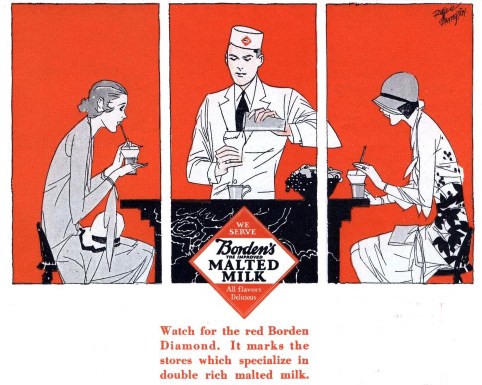
The new selections added in this week’s playlist update include 78 rpm records that Eddie The Collector played on Radio Dismuke’s recent New Year’s broadcast, a sampling of which you can hear below.
| “Miranda” Noble Sissle And His Orchestra; Noble Sissle, vocal. September 10, 1929 (HMV B 5709 mx 30 1029) |
| “Sleepy Chinese” The Castilians July 29, 1927 (Brunswick 3686 B) |
| “A Shady Tree” The Okeh Melodians; Vaughn DeLeath, vocal September 16, 1927 (Okeh 40905 mx 81448) |
| “Get ‘Em In A Rumble Seat” Horace Heidt Orchestra February 14, 1928 (Victor 21311 A mx 42004) |
| “Butter Finger Blues” Chas Creath’s Jazz O Maniacs May 2, 1927 (Okeh 8477 mx 80 823) |
| “Camp Meeting Day” Noble Sissle And His Orchestra; Noble Sissle, vocal September 10, 1929 (HMV B 5709 mx 30 1028) |
| “Original Two Time Man” The Cotton Club Orchestra April 28, 1925 (Columbia 374 D mx 140475) |
Both of the recordings presented here by Noble Sissle and His Orchestra, “Miranda” and “Camp Meeting Day” were recorded in London and, unlike some of Sissle’s other British recordings, were not issued in the USA. Between 1927 and 1931 Sissle and his band worked in the UK and Europe where they enjoyed a high level of success. He returned to the USA for an opportunity to have a network radio program on CBS. Sissle had an important and lengthy career that spanned from the ragtime era in the early 1910s through the late 1960s. An excellent overview of his life story, based on recollections by his son, Noble Sissle Jr. can be found in this article on The Syncopated Times website.
The recording of “Sleepy Chinese” by Mexican composer Rubén Darío Herrerais is anything but sleepy. While not jazzy, it has a very peppy, bouncy and rather charming arrangement. The Castilians was one of over 60 recording pseudonyms used for Louis Katzman’s in-house studio orchestra during his years at Vocalion and Brunswick Records. After having worked as an arranger and conductor for Edison Records starting in 1915, Katzman joined Vocalion in 1922 and remained after the label was purchased by Brunswick where he was eventually promoted to Music Director and, later General Manager. During the 1920s and 1930s, he directed bands for a number of network as well as local New York City radio programs. Two takes from the recording session were issued. The instrumental version featured here was intended for release in Germany but was issued in Brunswick’s USA popular series. A second version with a Spanish vocal was also issued for Spanish-speaking markets.
“A Shady Tree” features a sparkling arrangement performed by the Okeh Melodians, a recording pseudonym for the Sam Lanin Orchestra with a vocal by Vaughn DeLeath. Known as “The First Lady of Radio” she became the first female vocalist to perform on radio in 1920 and, during a 1928 experimental broadcast, the first female vocalist to perform on television. She also recorded hundreds of sides for Edison, Brunswick, Okeh, Victor and Columbia and is heard regularly on Radio Dismuke. Largely forgotten today, she was an artist who, in my view, deserves to be better remembered.
During the 1910s and 1920s, America’s love/hate relationship with the automobile was a favorite and presumably profitable topic for Tin Pan Alley songwriters. Usually, they poked fun of their reliability or celebrated them as an opportunity for romantic encounters. “Get ‘Em In A Rumble Seat” does the latter. The song was well suited for novelty groups such Harry Reser’s Six Jumping Jacks and the Happiness Boys, both of whom recorded it. This version by the Horace Heidt Orchestra is a dance band arrangement that features only abbreviated lyrics. Heidt is best remembered for his later band, Horace Heidt and His Musical Knights, which was popular on radio broadcasts during the late 1930s and 1940s. But, as demonstrated in certain passages on this recording, his 1920s dance band which recorded for Victor between 1927 and 1929 was often quite jazzy.
Charles Creath was a black jazz artist who began his career playing in traveling circuses and leading bands on Missississippi River riverboats. “Butter Finger Blues” was his own composition and was recorded in St. Louis, Missouri.
The Cotton Club Orchestra, after a few name changes, was eventually taken over by Cab Calloway. It was formed in 1923 in St Louis as Wilson Robinson’s Syncopators. In 1925, under the direction of violinist Andy Preer, it became The Cotton Club Orchestra as a result of being selected to be the house band for the famous Harlem nightclub of the same name. After Preer died in 1927 and Duke Ellington Orchestra took over as the club’s namesake band, it became The Missourians under the direction of vocalist Lockwood Lewis. Cab Calloway assumed control over the band in 1930. “Original Two Time Man” is a Walter Donaldson composition. This recording was made several months before Columbia switched over to the new electrical recording technology and thus has the lower fidelity that is inherent in acoustic-era recordings.
